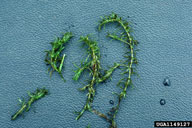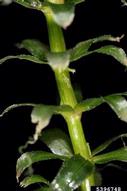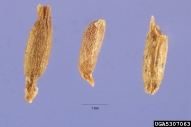| hydrilla | USDA PLANTS Symbol: HYVE3 U.S. Nativity: Exotic Habit: Aquatic Plants |
| Hydrilla verticillata (L. f.) Royle |
Jump to: Resources | Images | Distribution Maps | Sources
|
Taxonomic Rank: Liliopsida: Hydrocharitales: Hydrocharitaceae |
|
| Synonym(s): Florida elodea, water thyme, waterthyme | |
| Native Range: Europe; Old World (BAIL); | |
|
|
Identification, Biology, Control and Management Resources
|
| Selected Images from Invasive.org | View All Images at Invasive.org |
 Foliage; Robert Vidéki, Doronicum Kft., Bugwood.org Additional Resolutions & Image Usage |
 Plant(s); USDA APHIS PPQ - Oxford, North Carolina , USDA APHIS PPQ, Bugwood.org Additional Resolutions & Image Usage |
 Plant(s); Discovered in the Crystal River in south Florida in 1960. Raghavan Charudattan, University of Florida, Bugwood.org Additional Resolutions & Image Usage |
 Foliage; Robert Vidéki, Doronicum Kft., Bugwood.org Additional Resolutions & Image Usage |
 Foliage; Robert Vidéki, Doronicum Kft., Bugwood.org Additional Resolutions & Image Usage |
 Plant(s); Leslie J. Mehrhoff, University of Connecticut, Bugwood.org Additional Resolutions & Image Usage |
 Plant(s); David J. Moorhead, University of Georgia, Bugwood.org Additional Resolutions & Image Usage |
 Seed(s); Steve Hurst, USDA NRCS PLANTS Database, Bugwood.org Additional Resolutions & Image Usage |
| EDDMapS Distribution: This map is incomplete and is based only on current site and county level reports made by experts and records obtained from USDA Plants Database. For more information, visit www.eddmaps.org |
 State List This map identifies those states that list this species on their invasive species list or law. 
|
| U.S. National Parks where reported invasive: |
| Colonial National Historical Park (Virginia) George Washington Memorial Parkway (Virginia) National Capital Parks East (Washington, D.C.) |










